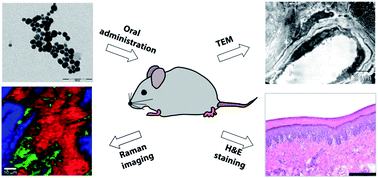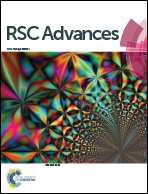Comparative evaluation by scanning confocal Raman spectroscopy and transmission electron microscopy of therapeutic effects of noble metal nanoparticles in experimental acute inflammation†
Abstract
Finding appropriate experimental designs and analysis methods in order to gain insight into the mechanisms of efficiency and toxicity of nanomaterials is a major focus in today’s research in nanomedicine. In this paper, we demonstrate the ability of scanning confocal Raman spectroscopy to emphasize the molecular changes in terms of inflammation resolution after administration of a single dose of metal nanoparticles functionalized with natural extracts, in experimental inflammation. Five experimental groups of Wistar rats were used, treated with one dose of gold nanoparticles (AuNPs–CM), one dose of silver nanoparticles (AgNPs–CM), Cornus mas (CM) extract, and vehicle, before intraplantar injection of 100 μL 1% carrageenan, and one group of untreated animals. The paw tissues were harvested and used for transmission electron microscopy (TEM) and evaluation of the metal content 4 and 24 hours after the induction of inflammation and, after 24 hours, Raman spectroscopy, histopathology and prostaglandin (PG) E2 level assessment were performed. TEM revealed varying degrees of alterations in dermo-epidermal junctions and capillaries, especially in tissues treated with AgNPs–CM and vehicle, in parallel with the increase in PGE2 levels. Besides ultrastructural changes highlighted by TEM, meaningful information about the molecular changes is provided by multivariate Raman spectral images. Indeed, thorough Raman spectral analysis shows that AuNPs–CM and CM restored the normal composition of unsaturated fatty acids while the specimens treated with AgNPs–CM were dominated by the protein component. Our results suggest that the Raman spectral analysis has real potential to be used in tandem with standard methods for monitoring the subtle molecular effects induced by the administration of nanoparticles.


 Please wait while we load your content...
Please wait while we load your content...